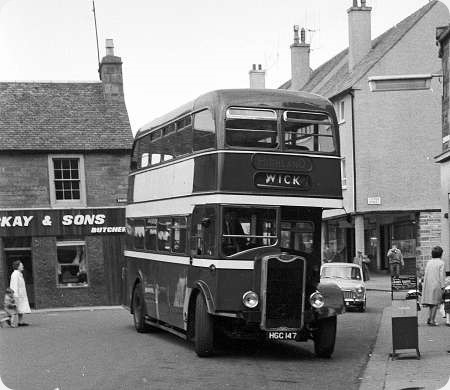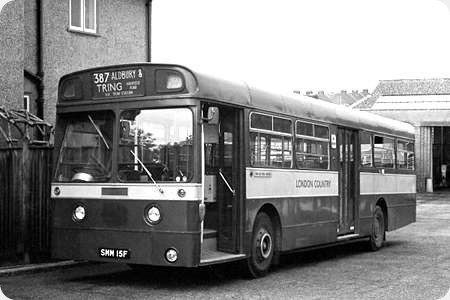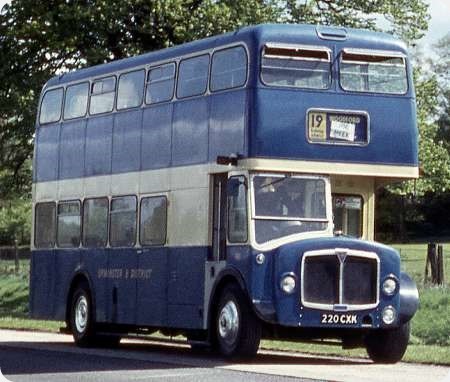Highland Omnibuses – Guy Arab – HGC 147 – E8
Highland Omnibuses Ltd
1945
Guy Arab II
Alexander L27/26RD (1952)
In July 1965 I did a tour of Scotland on a railrover – I think one week though it may have been two – the object of which was to cover as much of the existing passenger rail network as possible, many of the lines being threatened with closure at that time. There was little time to do any bus photography, as arrival in a town at the end of daylight with no booked accommodation meant that finding this was first priority. Then it would be up in the morning for the earliest appropriate departure.
One of the very few occasions where leisure was enforced was near the beginning of the adventure, on my arrival in the far north of Scotland. The railway timetable simply didn’t allow the Thurso and Wick branches to be covered exclusively by rail without an inordinate waste of time. Having arrived at Thurso around 4 pm, it was then a matter of finding a bus to take me to Wick, from where I would catch the early train back to Inverness.
Highland was very much the ‘Second-hand Rose’ of the Scottish Bus Group, particularly as far as double-deck buses were concerned. As far as I can make out, none were bought new between a Guy Arab IV in 1950 and a batch of Fleetlines in 1978.
Having observed (and photographed) a ‘new’ (1963) Lowlander – recently transferred from Central – on the Scrabster service, and a venerable former Scottish Omnibuses Arab II – still with utility body – on the town service to Mount Vernon, I was quite happy to see E8 as seen above turn into the High Street with its destination showing Wick.
HGC 147 began life as London Transport G368, a Guy Arab II with Massey H30/26R utility bodywork. LT’s Guys were always odd-men-out, so had a short life, being withdrawn with the expectation of sale for further use in the early 1950s. The Scottish Bus Group took a number of them, and 19 found their way to Western SMT who in 1952 replaced the utility bodies with smart new Alexander low-bridge bodies in their domed style. HGC 147 took WSMT fleet number 1005. 13 years later, the chassis now fully 20 years old, E8 was still looking smart.
Photograph and Copy contributed by Alan Murray-Rust
20/05/19 – 07:24
These Massey G’s were delivered in the second half of 1945 and probably had the weakest, certainly the most ugly, utility bodies of all LT’s vehicles of this type. ‘Ian’s Bus Stop’ website states that she was acquired for use on Dounray work. She certainly looks smart here and was finally retired in May 1967.
Chris Hebbron
23/05/19 – 06:57
As an afterthought, Alan, I’d hazard a guess that the drivers (and probably conductors) of these venerable vehicles, with austerity bodies or not, would have rued the day that they were ousted by the truly awful Albion Lowlander.
Chris Hebbron
09/06/19 – 10:51
The Guy Arab in its well known guise evolved entirely from the advent of the Second World War, and had it not done so, then, as respected author Robin Hannay confirms, the Guy company would probably have disappeared entirely by 1950. The original Arab FD model (the code stood for forward control type ‘D’, as the previous Guy buses had carried the letter ‘˜C’ – the ‘D’ did not, as often stated, stand for ‘diesel’) came on the market in 1933, carrying forward much of the design philosophy from the FC Invincible that preceded it, and, indeed, an FC demonstrator was rebuilt by Guy as an Arab. This early Arab design was conceived within the Leyland TD1 school of thought, with the engine, driving position and front bulkhead set back from the front axle; this enabled the accommodation of the Gardner 6LW engine, though the 5LW was the usual power unit. The neater front end structure of the AEC Regent had already arrived in 1929 and, strangely, the contemporary Guy trolleybuses did have a tidy frontal design. 1933 also heralded the appearance of the Leyland TD3 with a compact front end but the somewhat autocratic Sidney Guy maintained his own strong beliefs on the subject of bus design. The production run run of the original double deck Arab lasted until 1936, during which period about 50 were made, though Burton on Trent Corporation Transport, a confirmed user of the 4LW powered Arab in its single deck guise, took six more in 1940 and a further six in 1941. Between 1936 and the early years of the war Guy produced vehicles for the military, but even this activity trailed off when the orders for searchlight vehicles were cancelled as radar played a greater role in detecting enemy aircraft. With the outbreak of war all new bus production was halted, being slightly relaxed subsequently to permit the assembly of ‘unfrozen’ chassis. It soon became clear that something had to be done to meet the urgent need for new buses, and, in 1941, officialdom turned first to Leyland, but also (to general astonishment, since it had not been a significant double deck manufacturer for five years) to Guy. When Leyland withdrew due to the pressures of other wartime work, operator astonishment turned to apprehension that the industry’s needs were to be met solely by the Guy company. The original Arab design was clearly outdated and Major Chapple of Bristol offered Sidney Guy the drawings for the K5G, but Mr Guy was having none of it. His new bus would be a Guy, but the shape of the redesigned chassis showed very close similarities with that of that of the Leyland TD7 (a wartime version of which was originally expected to be supplied also), though established Guy transmission units were incorporated. The subsequent history of the Arab Utility is well documented, and its rugged dependability became legendary, even though the ‘˜back to front’ selector positions of the original crash gearbox was not a universally popular feature. However, London Transport drivers did not like the Arab, and the members of the G class were disposed of as soon as the new London Transport Executive could get rid of them, even though they were mechanically sound with years of life potentially ahead. In the booming post war public transport period there was a somewhat paranoid attitude by the Labour government about the disposal of nationalised undertakings’ assets to companies within the UK but outside the state fold, and very many of these Arabs were sold abroad instead. Even Edinburgh Corporation had a mighty struggle to get sixty surplus Arabs from LT. However, the Scottish Motor Traction group was nationalised in 1949 and thus became an acceptable recipient for former London machinery which, like HGC 147, then went on to give sterling service for very many years.
Roger Cox
10/06/19 – 07:41
I believe all London Transport’s Guy Utilities had the 5LW engine and this one, despite having the protruding radiator, appears to have had it’s upturned front wings cut back. It also retains the Arab II high bonnet line although I understand a conversion kit was available to achieve the lower bonnet line of the Arab III, perhaps Western thought the extra expense was unjustified – a shame really because it would have made a nice looking bus even better.
Chris Barker
Quick links to the - Comments Page - Contact Page - Home Page



